3 Best Asynchronous Communication Tools in 5 Key Categories
Asynchronous communication tools are a great way to manage communications and improve your productivity at work. But picking the right ones can be a challenge!
So we’ve done the hard work for you. In this blog, we take a look at the top 3 asynchronous communication tools across 5 different categories, from video communication to brainstorming tools.
Here’s what we’ll cover in this post if you’d like to skip ahead:
- Synchronous vs Asynchronous Communication
- Top 5 Benefits of Asynchronous Communication
- 5 Main Categories of Asynchronous Communication Tools
DISCLAIMER: Our product is eWebinar, an asynchronous webinar platform and video communication tool. Webinars are typically not mentioned in conversations involving asynchronous communication. We’re here to change the convo. 😁
Synchronous vs Asynchronous Communication
Synchronous communication is when two or more parties exchange messages or speak in real time. Phone calls, in-person client meetings, Zoom calls, and live webinars are all examples of synchronous communication.
Asynchronous communication happens ‘out of sync.’ It occurs when people aren’t present simultaneously for a conversation. With async communication you can interact with another person without needing them to be present. Email, voicemail, and the collaborative features of a Google Doc are some examples of asynchronous communication tools.
The main difference between asynchronous and synchronous messaging is the timing of the conversation. With synchronous communication, as the name suggests, the back and forth happens in real time, while with asynchronous communication there is a delayed response.
Many messaging apps and other tools support a combination of synchronous and asynchronous communication, which allows people to choose whether to respond immediately or delay interaction. Text messages and instant messaging platforms like Slack are good examples of tools that allow both.
For effective communication, you’ll need to use a combination of both synchronous and asynchronous tools
Top 5 Benefits of Asynchronous Communication
While you may not get an immediate response with asynchronous communication, this medium has quickly become a life-saving tool. Real-time communication has it’s benefits, yes, but the advantages of asynchronous communication are huge and indispensable.
Here are the top 5 benefits of asynchronous communication:
1. More efficient form of communication
Asynchronous communication removes the need for real-time virtual meetings, which can save workers a ton of time. Remote teams benefit as they can collaborate on projects from different time zones without the hassle of finding a convenient time for everyone to meet.
2. Encourages deep work
Taking away the pressure of instant responses eliminates the increased effort that comes from context switching between focused work and responding to chats, handling multiple requests, and participating in meetings. Creating a distraction-free environment for work can boost productivity, encourage deep work, and give teams control over their own time.
3. Elicits high-quality responses
Since immediate responses aren’t needed with asynchronous communication, team members have more time to think, making it much more likely that they will deliver insightful and more in-depth feedback. Introverted team members are also more likely to participate in discussions and contribute ideas. It can also reduce conflict and knee-jerk responses that can often occur in high-stress situations.
4. Boosts team morale
Since employees are able to control when they respond to requests and when to focus on deep work, asynchronous communication helps keep teams happy. In a world where everyone is expected to be available all the time, the ability to define one's working hours can really boost team morale by allowing people to create a better work-life balance.
5. Creates a record
With asynchronous communication, there is an ongoing record that documents your progress from the start. Senior leadership can be kept in the loop without having to attend every meeting or brainstorming session. Team leaders and managers also have easy access to historical information they can review when necessary. At the end of a project, there is a central knowledge base that can be referred to for future projects.
5 Main Categories of Asynchronous Communication Tools
Now let’s take a look at 15 asynchronous collaboration tools you can use for remote work. Because there are so many kinds of async communication tools, we’ve included the three top tools in five main categories:
- Asynchronous Video Communication Tools
- Asynchronous Messaging Tools
- Asynchronous Project Management Tools
- Asynchronous Collaboration Tools
- Asynchronous Brainstorming Tools
3 Best Asynchronous Video Communication Tools
eWebinar
- Pricing: Starts at $99/month
- Visit eWebinar

eWebinar is an asynchronous webinar platform that combines pre-recorded video with real-time interactions and live and/or asynchronous communication to deliver an engaging webinar experience for attendees.
For a brief overview of how eWebinar works, watch this 2-minute explainer video:
For a detailed overview of eWebinar, join our 20-minute on-demand demo. We use our product to demo our product, so you’ll not only get to learn how eWebinar works, you’ll get to experience an asynchronous webinar firsthand.


A pre-recorded webinar, by nature, is an asynchronous event. Because it does not need to be scheduled to accommodate the host’s availability, it can be made available 24/7 so that people can attend it at their convenience.
What makes an asynchronous webinar created with eWebinar different from, say, watching a video on YouTube is it still has the core elements of a webinar: chat and interactivity.
Here is how those two things work in eWebinar:
Flexible chat system (for both asynchronous and synchronous communication)
eWebinar’s robust chat system gives you the freedom to respond to chat messages in real time or asynchronously at your convenience. This lets you tackle questions at your own pace instead of trying to keep up with the rapid-fire chat messages that most hosts encounter when opting for live presentations.
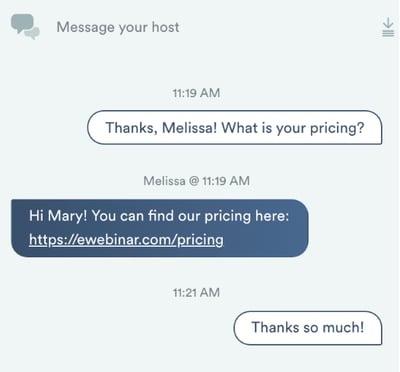 Here is how chat works:
Here is how chat works:
- When an attendee sends a chat message, you get notified by email, browser notification, and/or Slack, per your preference.
- If you or your team are available — you can invite as many people as you like to help you moderate chat — you can jump in and have a conversation in real time.
- If you are not available, an auto response lets attendees know you will get back to them later. This manages their expectations of your response time and puts them at ease knowing their message was received.
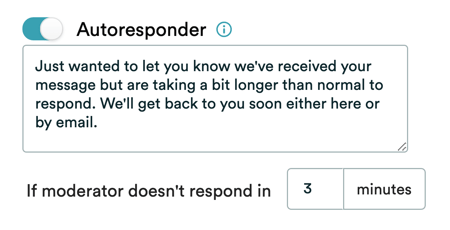 When you do reply, your response is sent to the attendee by email.
When you do reply, your response is sent to the attendee by email.
The beauty of this system is you have the flexibility to respond to messages from attendees live (synchronously) or later (asynchronously) as needed, without being forced to choose one way or the other — or leaving your attendees hanging.
No other webinar platform has this feature.
eWebinar’s chat lets you create a personalized experience at scale, one in which the attendee always has a direct line of communication to you. For Customer Success and Sales teams, the ability to retain this kind of personal touch at scale is pure gold.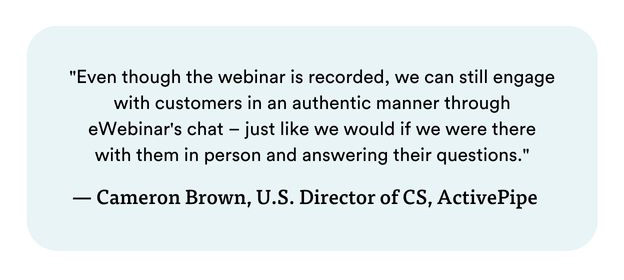
Interactivity for gathering feedback asynchronously
Interactivity in a webinar serves two main purposes. It helps keep your audience engaged so they stay until the end and lets you gather feedback.
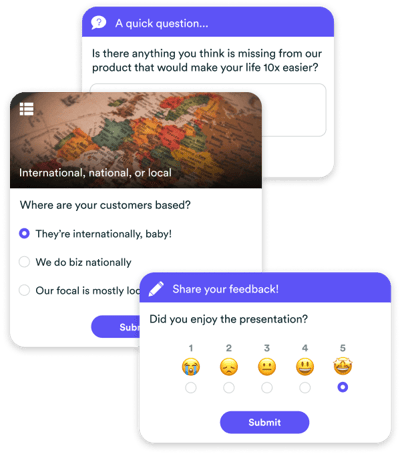 In eWebinar, interactions like polls, questions, quizzes, tips, special offers, feedback forms, and more can be pre-programmed to appear at precisely the right moments in your video presentation. Knowing you have this capability lets you plan and script your webinar such that you can create a truly engaging experience from beginning to end.
In eWebinar, interactions like polls, questions, quizzes, tips, special offers, feedback forms, and more can be pre-programmed to appear at precisely the right moments in your video presentation. Knowing you have this capability lets you plan and script your webinar such that you can create a truly engaging experience from beginning to end.
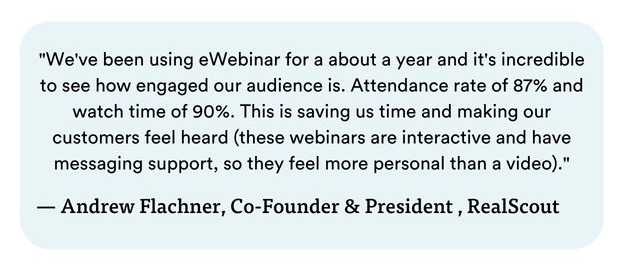 In the context of this post, however, these interactions are their own form of asynchronous communication. You can ask questions, which the attendee experiences in real time (in sync with the video), and gather responses asynchronously as more and more people attend the webinar over time.
In the context of this post, however, these interactions are their own form of asynchronous communication. You can ask questions, which the attendee experiences in real time (in sync with the video), and gather responses asynchronously as more and more people attend the webinar over time.
Here is an example of how this interactivity works:
- You say something during your webinar like, “What role do you play in your company? Is it sales, marketing, customer success, or something else? I’d love to know.”
- You schedule a Poll to appear at that exact moment in your video with that question.
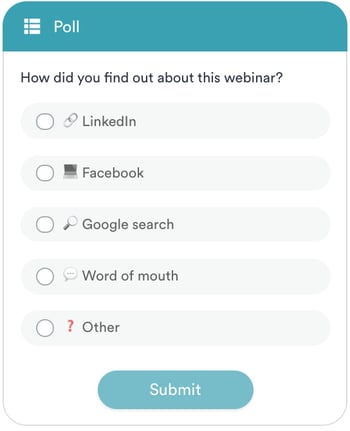 For attendees, the Poll appears “automagically” as if you’d manually triggered it in the moment.
For attendees, the Poll appears “automagically” as if you’d manually triggered it in the moment. - Poll results accumulate over time as more and more people attend your webinar, meaning the longer it runs the better intel you have about the audience breakdown of your webinar.
- You can send attendee responses from the Poll to your CRM for targeted post-webinar follow-up.
It's the best of both worlds. Your communication is asynchronous — the presentation is pre-recorded and interactions are pre-programmed in advance — while the attendee has an on-demand webinar experience that has the feeling of a live event — with real-time interactions and a direct line of communication to the host.
To experience the asynchronous communication of an automated webinar, join our on-demand sales demo now.


Loom
- Pricing: Free - $8/month for advanced features
- Visit Loom
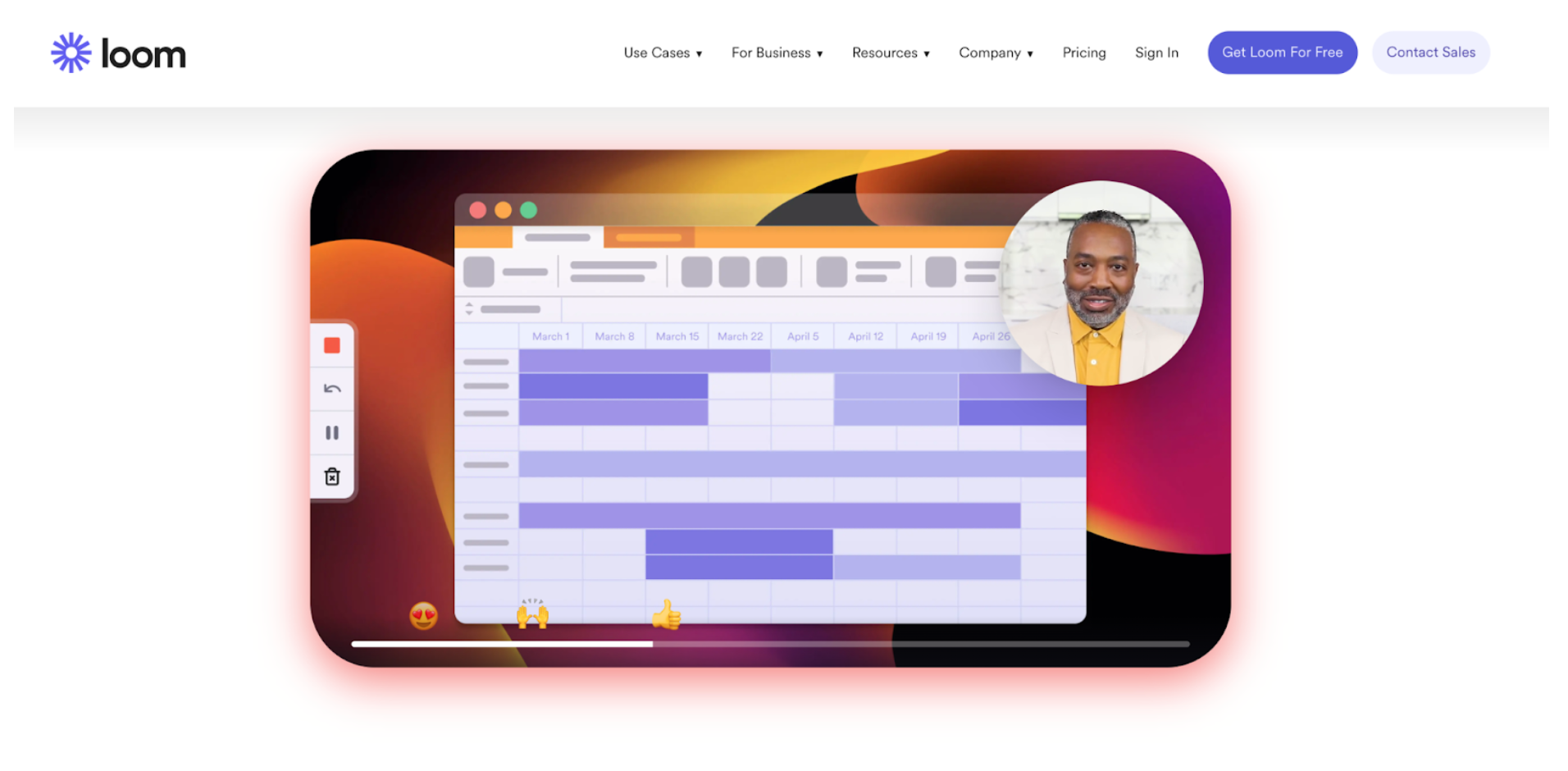
Loom is great for asynchronous communication and team collaboration. It provides an effective way for remote workers to screenshare and record videos. You can create instructional videos and tutorials, record directions or even send updates to your team! Recording video is easy and intuitive which makes Loom a great alternative when Zoom video calls are difficult to coordinate.
CloudApp
- Pricing: Free - $8/per user/month for Team plan
- Visit CloudApp
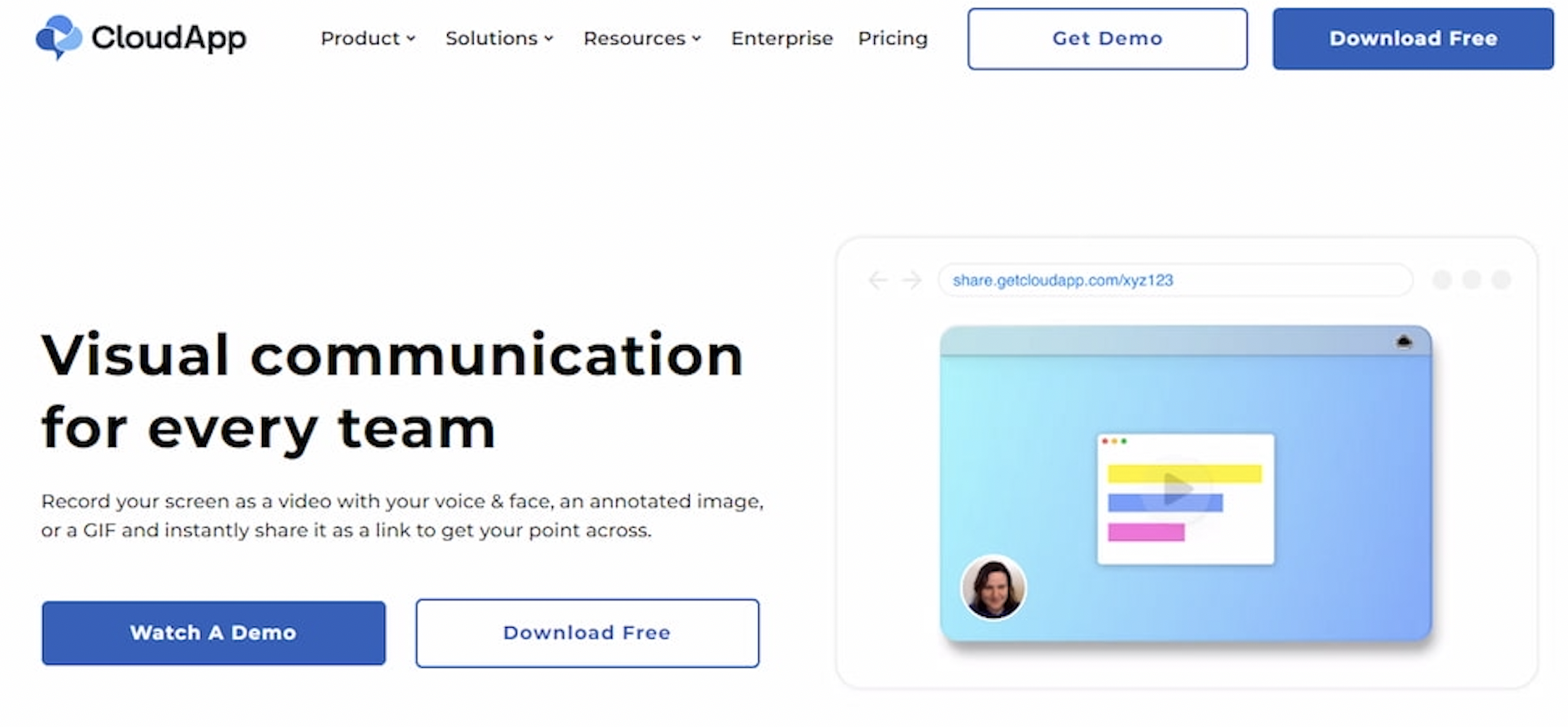 CloudApp is an all-in-one video and image sharing platform. With CloudApp you can capture and embed video, webcam, GIFs, screencasts and marked up images throughout business workflows (eg. software development, design, customer success, support, sales, marketing).
CloudApp is an all-in-one video and image sharing platform. With CloudApp you can capture and embed video, webcam, GIFs, screencasts and marked up images throughout business workflows (eg. software development, design, customer success, support, sales, marketing). CloudApp’s screen recorder makes it easy to collaborate asynchronously across multifunctional teams through visual communication. From the smallest business customer to the largest enterprise client, CloudApp simplifies the way teams work together.
3 Best Asynchronous Messaging Tools
Slack
- Pricing: Free - $12.50/per person/month for Business+ plan
- Visit Slack
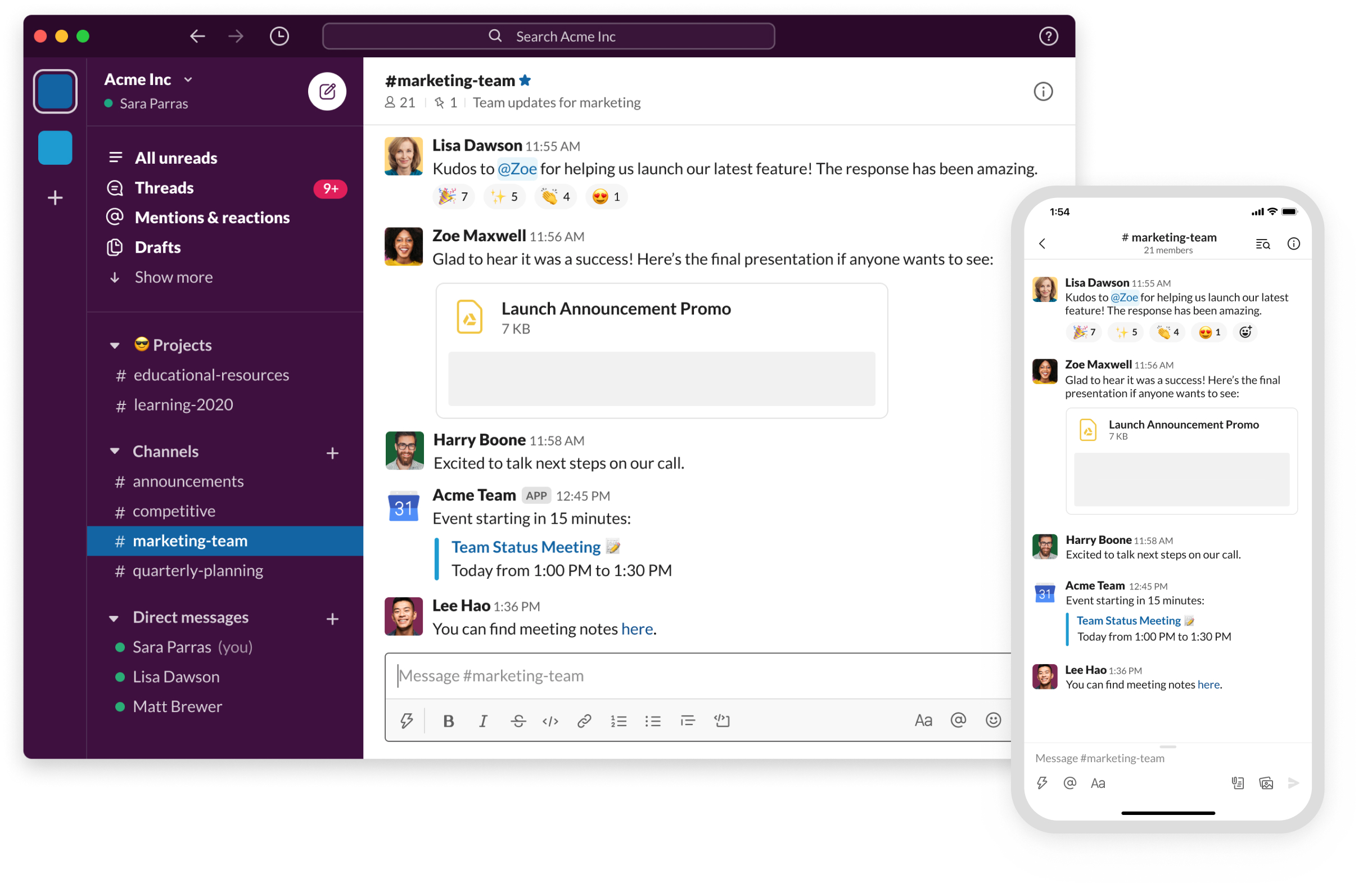
While Slack can also be used as a form of synchronous communication, it is also an effective way to update team members and keep track of ongoing discussions and projects asynchronously. Slack is a chat room for your company, designed to replace email as the primary method of communication. Instead of one-off email chains, all your communication is organized into channels that are easy to create, join and search. Slack also comes with a ton of integrations so you can manage your workflows on a single platform.
Yac
- Pricing: Free - $3/per user/month for Teams plan
- Visit Yac
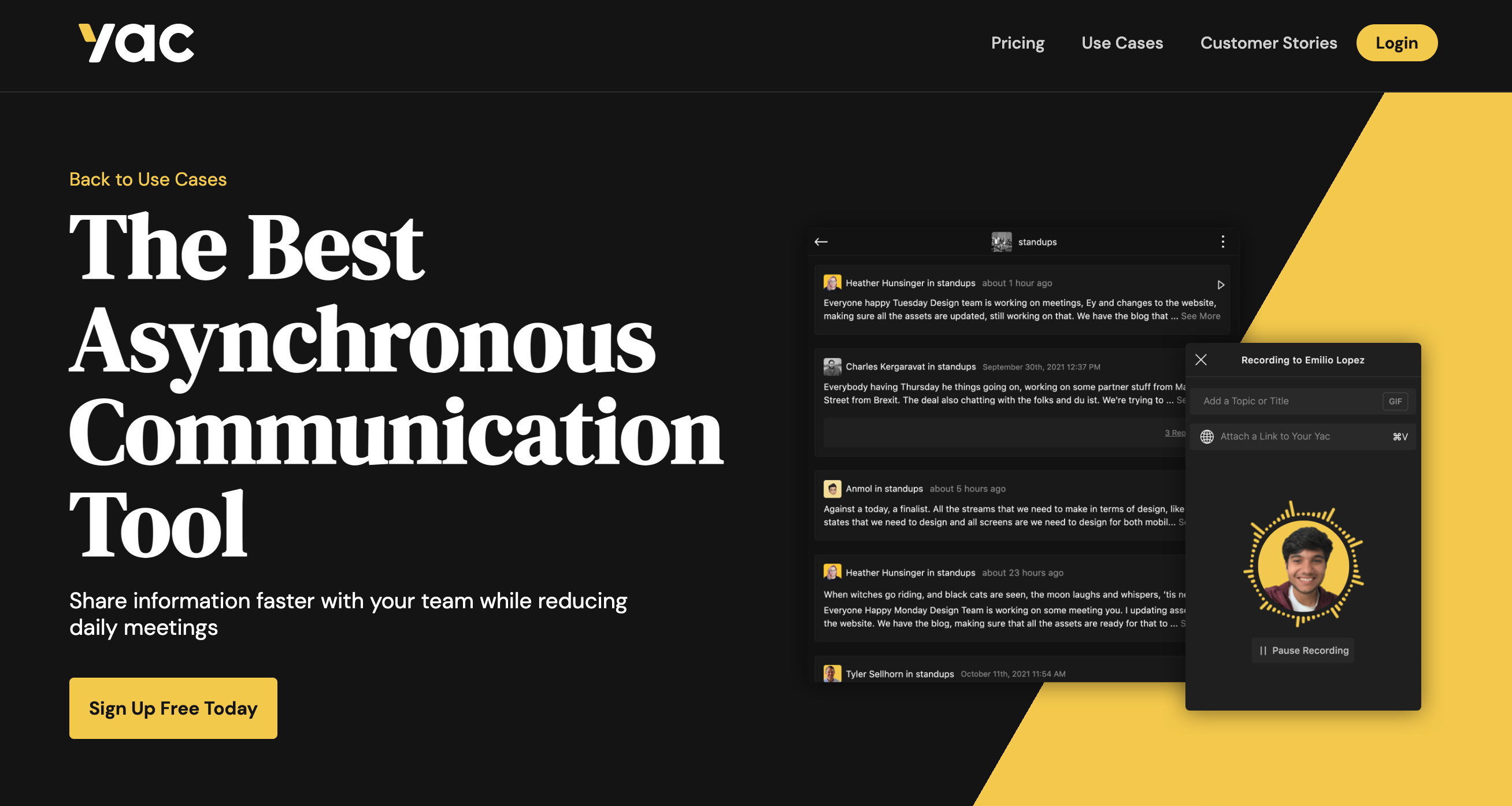 Yac is an audio-first communication platform that helps you to collaborate asynchronously. With Yac you can work one-on-one or in groups, share knowledge, and create new opportunities for productive discussions. Instead of having face-to-face team meetings on Zoom, you can use Yac to record a quick voice message to keep your teams in sync. What’s more it has a great integration with Slack, which makes coordination even easier!
Yac is an audio-first communication platform that helps you to collaborate asynchronously. With Yac you can work one-on-one or in groups, share knowledge, and create new opportunities for productive discussions. Instead of having face-to-face team meetings on Zoom, you can use Yac to record a quick voice message to keep your teams in sync. What’s more it has a great integration with Slack, which makes coordination even easier!
Twist
- Pricing: Free - $6/per user/month for Unlimited plan
- Visit Twist
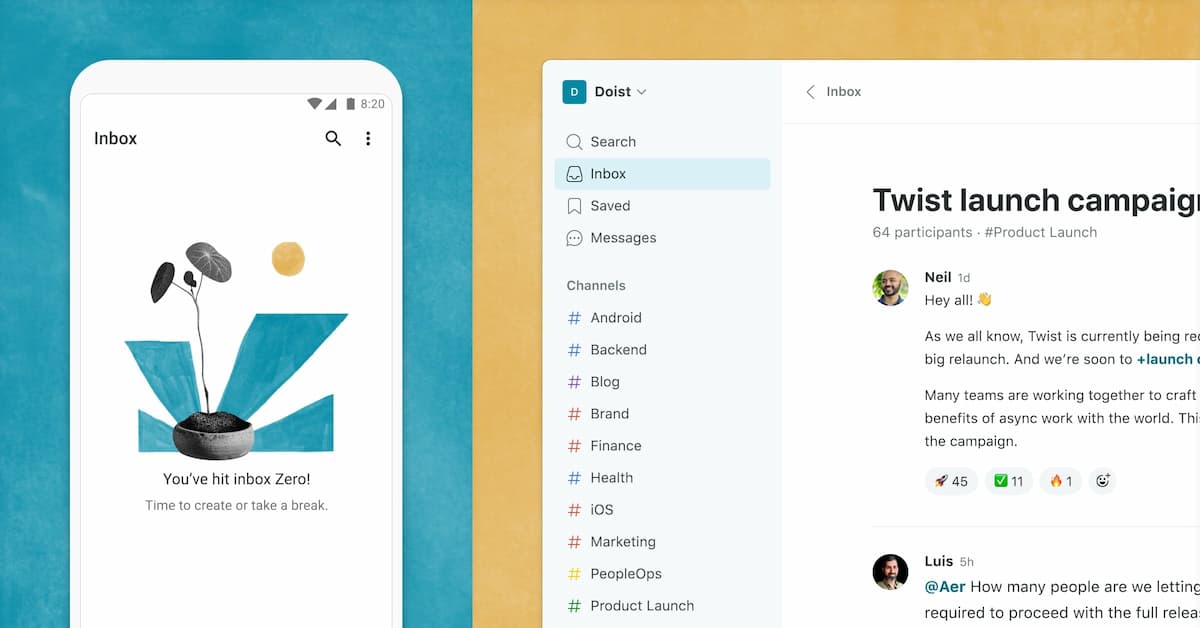
Twist is an innovative messaging tool that aims to disrupt real-time team communication in the workplace. This asynchronous communication tool gives you complete control over notifications by organizing your inbox into searchable threaded conversations that allow you to catch up at your convenience. Get notifications when, how and where you want. You can even opt only to receive notifications for specific one-on-one conversations. Twist also allows you to create channel groups and organize conversations by subjects, projects, or department.
ications by organizing your inbox into searchable threaded conversations that allow you to catch up at your convenience. Get notifications when, how and where you want. You can even opt only to receive notifications for specific one-on-one conversations. Twist also allows you to create channel groups and organize conversations by subjects, projects, or department.
3 Best Asynchronous Project Management Tools
Trello
- Pricing: Free - $10/per user/month
- Visit Trello
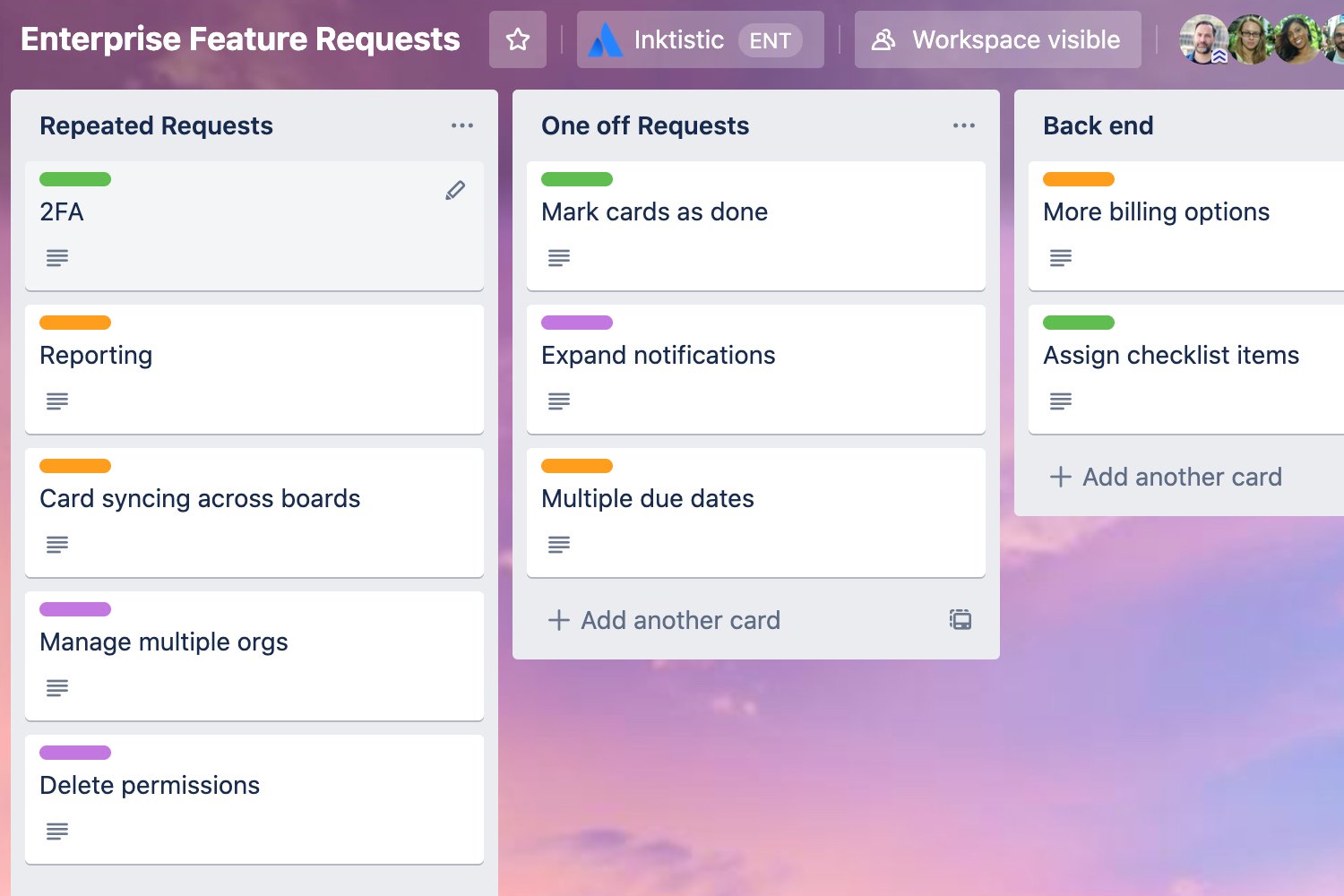
Trello is a visual project management tool for businesses that want to streamline their work. It relies on a project board (also known as a Kanban board) to conceptualize a workflow. Remote teams can easily manage any type of project, workflow, or task tracking with Trello. You can add files, checklists, or even automation and use integrations to customize how you’d like your team to engage with Trello.
Tip: Trello has third-party integrations with remote team communication tools like Slack that let you add cards to your board by sending a message through internal channels.
Asana
- Pricing: Free - $24.99/per user/month
- Visit Asana
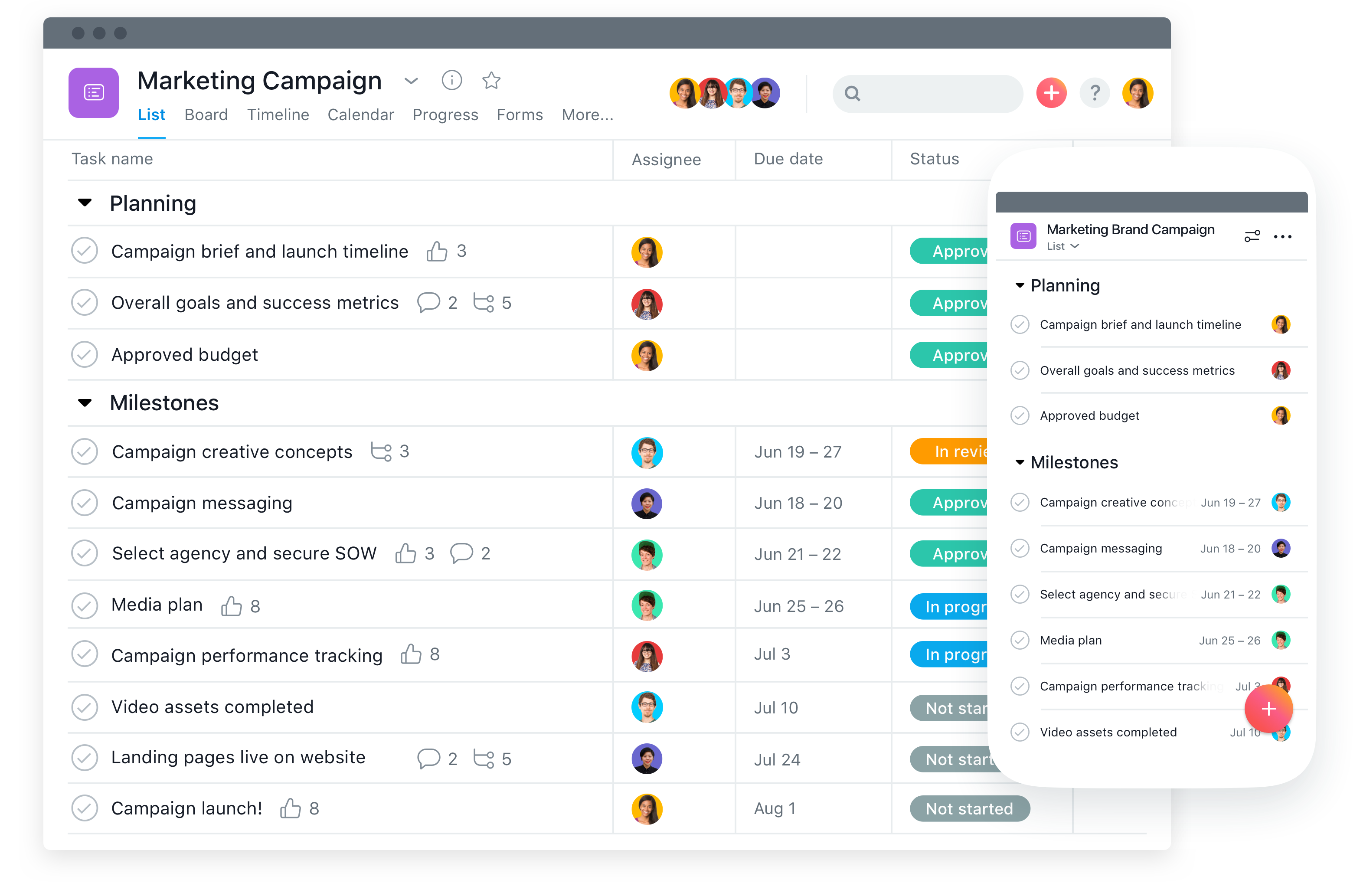 Asana is a customizable workplace content management system (CMS) designed to help companies streamline projects. You can analyze progress and address issues on a single platform, eliminating the need for constant video meetings, email updates, and memos. Asana also supports file sharing, milestones, deadlines, and progress tracking to keep the whole team on the same page.
Asana is a customizable workplace content management system (CMS) designed to help companies streamline projects. You can analyze progress and address issues on a single platform, eliminating the need for constant video meetings, email updates, and memos. Asana also supports file sharing, milestones, deadlines, and progress tracking to keep the whole team on the same page.
Wrike
- Pricing: Free - $24.80/per user/month
- Visit Wrike
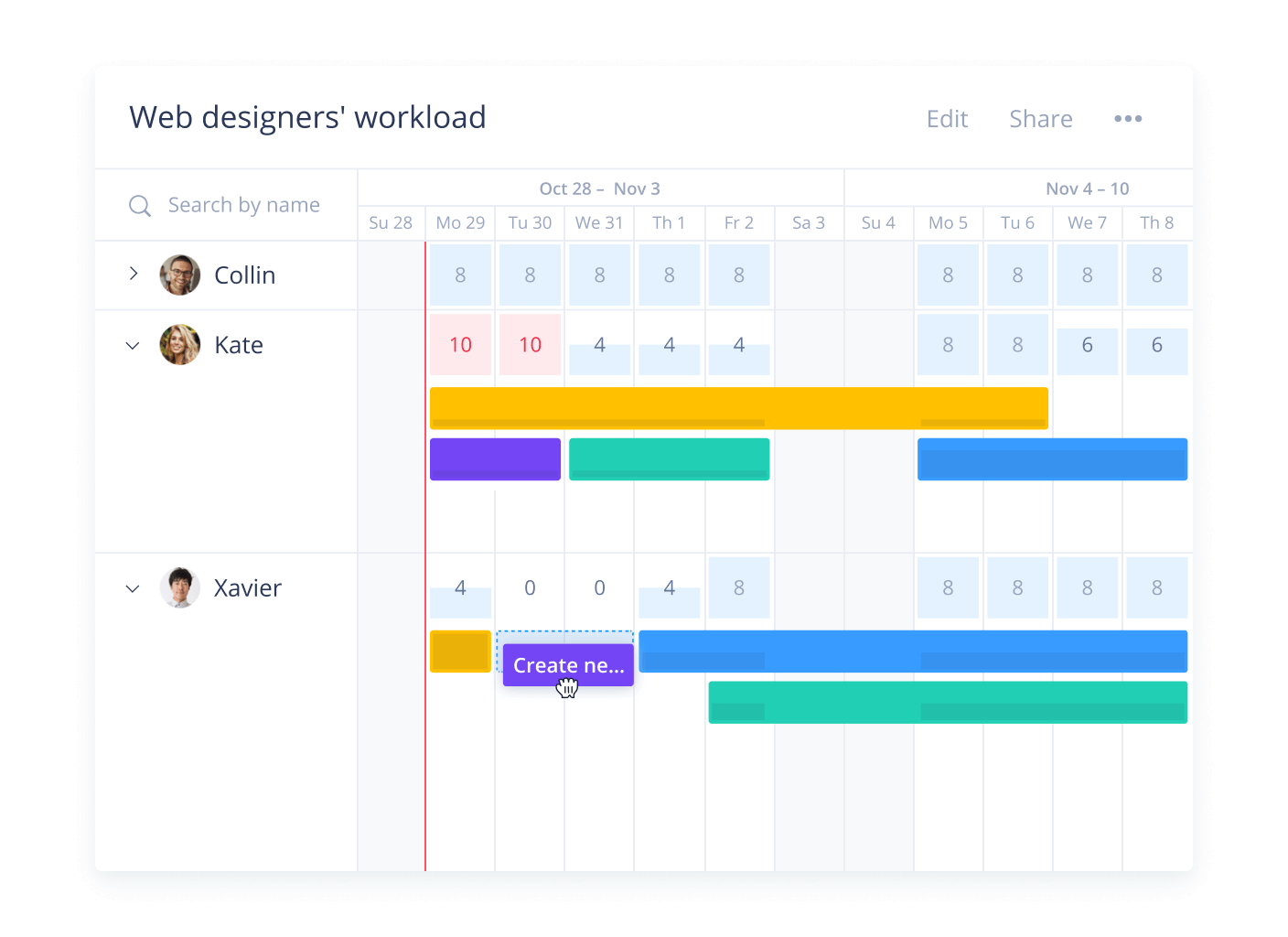 Wrike is a digital work management tool that lets users track and coordinate projects, combining a simple user experience and interface with enough depth for power users. Wrike provides a range of visual methods for businesses to track the progress of work including kanban-style boards, a list view, spreadsheet tables and Gantt charts.
Wrike is a digital work management tool that lets users track and coordinate projects, combining a simple user experience and interface with enough depth for power users. Wrike provides a range of visual methods for businesses to track the progress of work including kanban-style boards, a list view, spreadsheet tables and Gantt charts.
Wrike’s third-party integrations and API allows users to seamlessly integrate the platform with existing workflows.
3 Best Asynchronous Collaboration Tools
Google Workspace
- Pricing: Free - $12/per user/month
- Visit Google Workspace
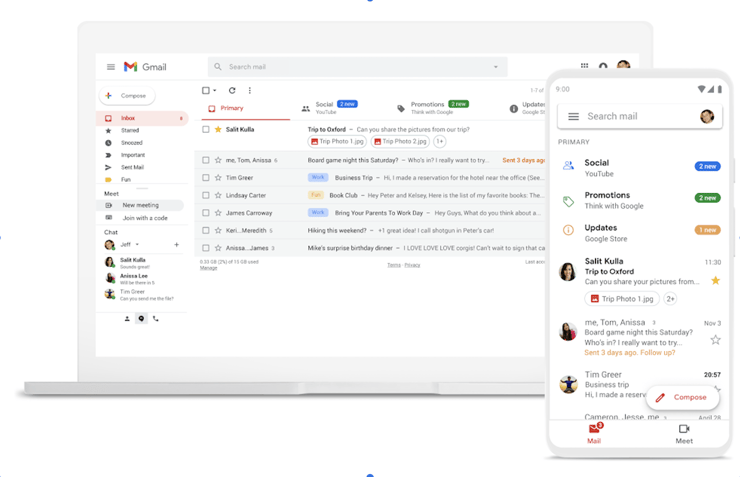 Google Workspace brings your entire work environment online with products everyone frequently uses in their workflows. Google Workspace consists of Google Docs, Sheets, Slides, Forms, Sites, Keep, Meet, Google Drive, Chat, Calendar, Gmail, Google Spaces, and more.
Google Workspace brings your entire work environment online with products everyone frequently uses in their workflows. Google Workspace consists of Google Docs, Sheets, Slides, Forms, Sites, Keep, Meet, Google Drive, Chat, Calendar, Gmail, Google Spaces, and more.
While some tools in Google Workspace (like Google Meet and the Chat feature) can be used for synchronous communication, apps like Docs and Sheets allow for asynchronous communication as people can respond to comments, view files and folders stored in Google Drive, and email colleagues using Gmail, in their own time. Perhaps Workspace’s greatest benefit is that all of its tools work seamlessly together.
You can select from tailor-made plans for startups, businesses, enterprises, individuals, nonprofits, and education.
Notion
- Pricing: Free - $8/per user/month
- Visit Notion
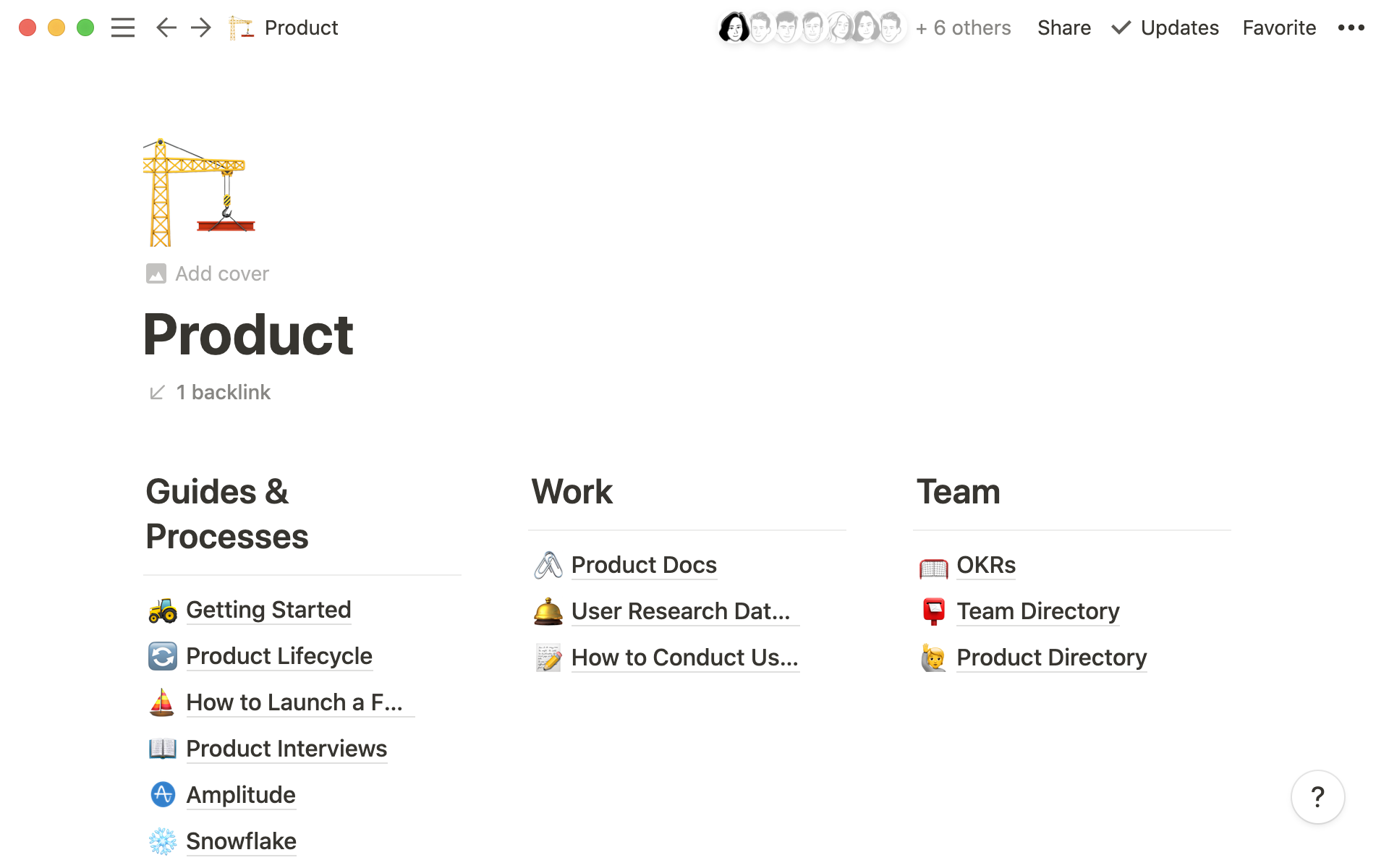 Notion comes with a wide array of tools and custom templates to make organizing easy. It allows you to take notes, add tasks, manage projects and more. The best thing about Notion is its workspace which allows you to write in a beautiful clean space, build your own personal wiki (with endless layers of content), plan using a kanban view, a calendar or a simple list and capture your workflows.
Notion comes with a wide array of tools and custom templates to make organizing easy. It allows you to take notes, add tasks, manage projects and more. The best thing about Notion is its workspace which allows you to write in a beautiful clean space, build your own personal wiki (with endless layers of content), plan using a kanban view, a calendar or a simple list and capture your workflows.
Confluence
- Pricing: Free - $11/per user/month
- Visit Confluence
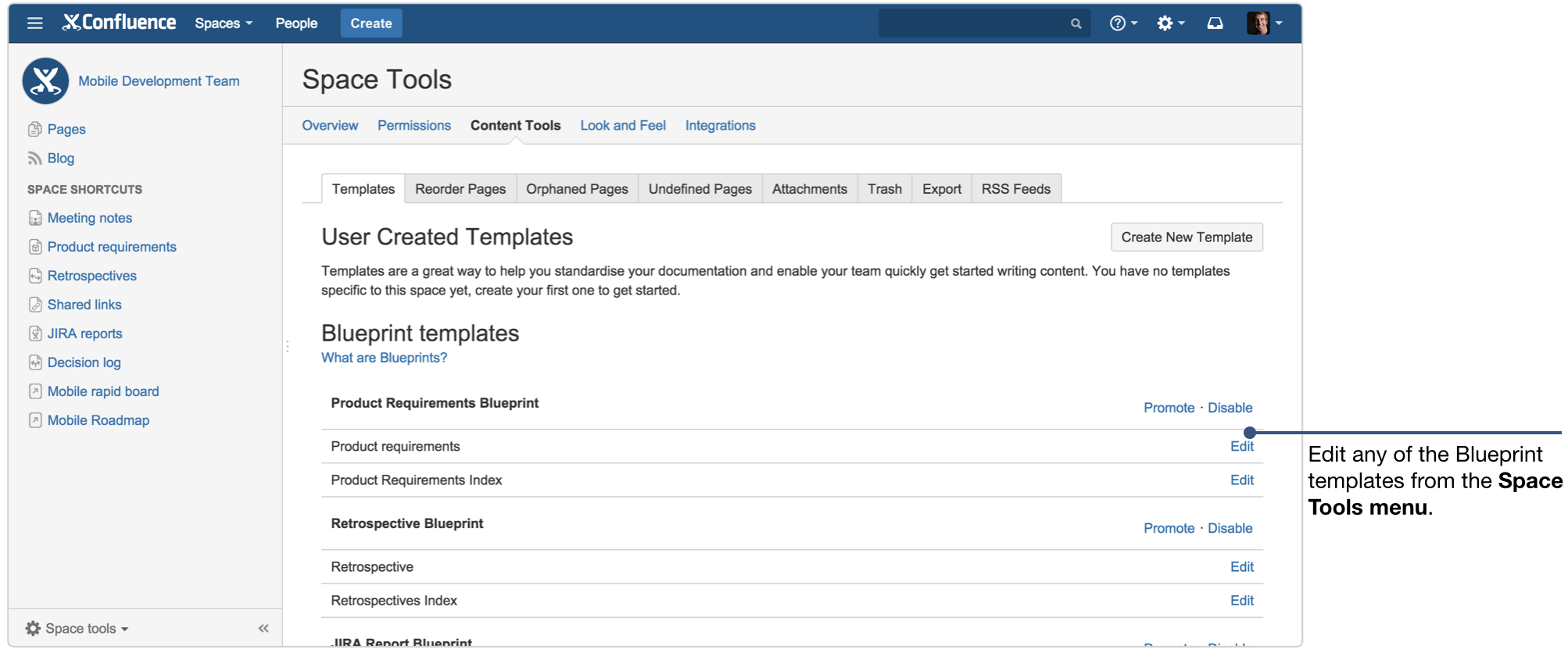 Confluence serves as an open, shared workspace that can be used not just as a knowledge base and for document and file-sharing, but for ongoing collaboration and communication. Dynamic pages give your team a place to create, capture, and collaborate on any project or idea. Spaces help your team structure, organize, and share work, so every team member has visibility into institutional knowledge and access to the information they need to do their best work.
Confluence serves as an open, shared workspace that can be used not just as a knowledge base and for document and file-sharing, but for ongoing collaboration and communication. Dynamic pages give your team a place to create, capture, and collaborate on any project or idea. Spaces help your team structure, organize, and share work, so every team member has visibility into institutional knowledge and access to the information they need to do their best work.
3 Best Asynchronous Brainstorming Tools
Mural
- Pricing: Free - $9.99 per user/month
- Visit Mural
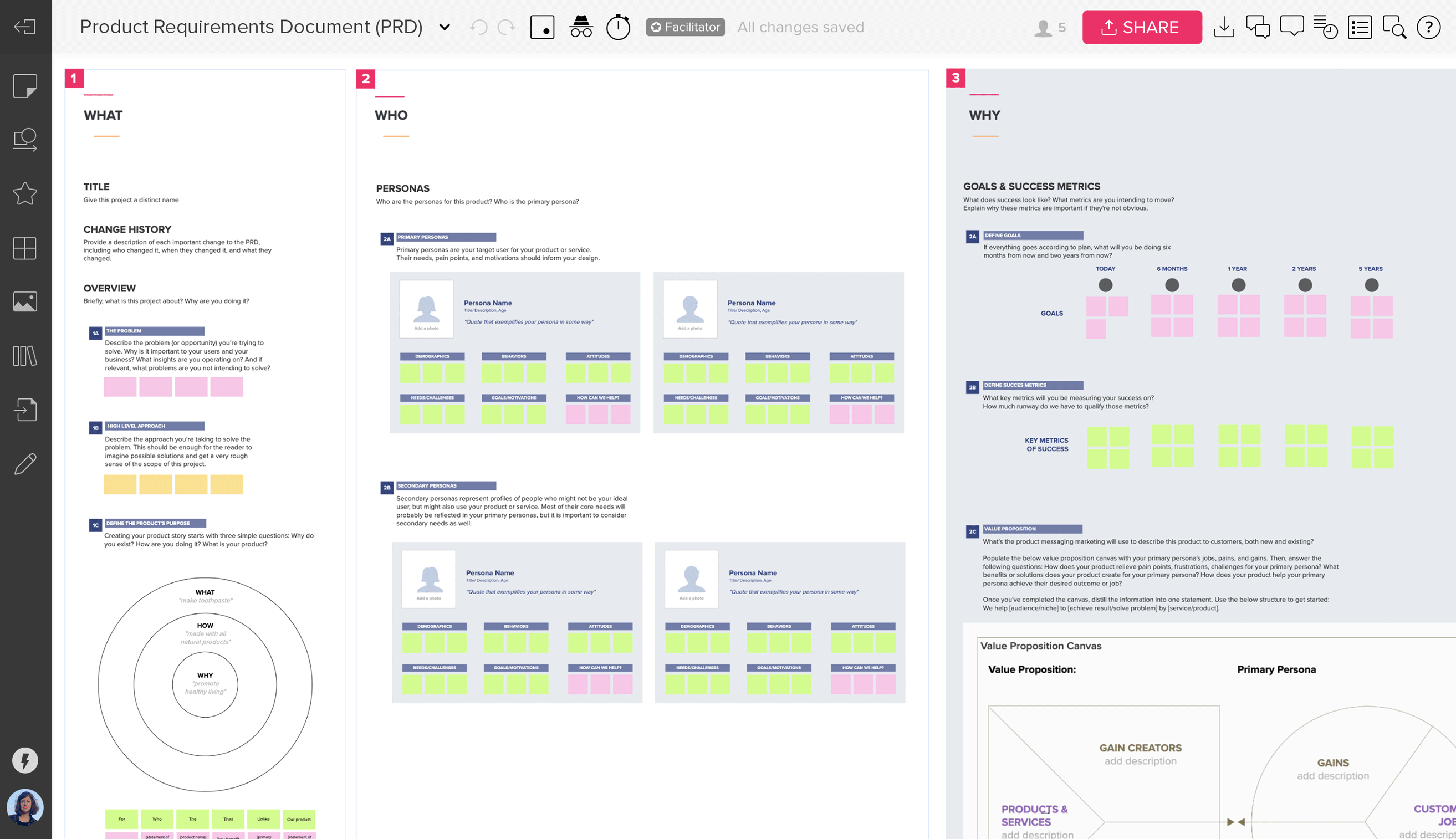 Mural is a digital whiteboard and workspace that helps remote teams ideate and solve problems together. Using visual collaboration tools like Mural can be really helpful for brainstorming, encouraging creativity and ensuring that everyone’s voice is heard - especially with teams in different time zones and locations.
Mural is a digital whiteboard and workspace that helps remote teams ideate and solve problems together. Using visual collaboration tools like Mural can be really helpful for brainstorming, encouraging creativity and ensuring that everyone’s voice is heard - especially with teams in different time zones and locations.
Miro
- Pricing: Free - $16 per user/month
- Visit Miro
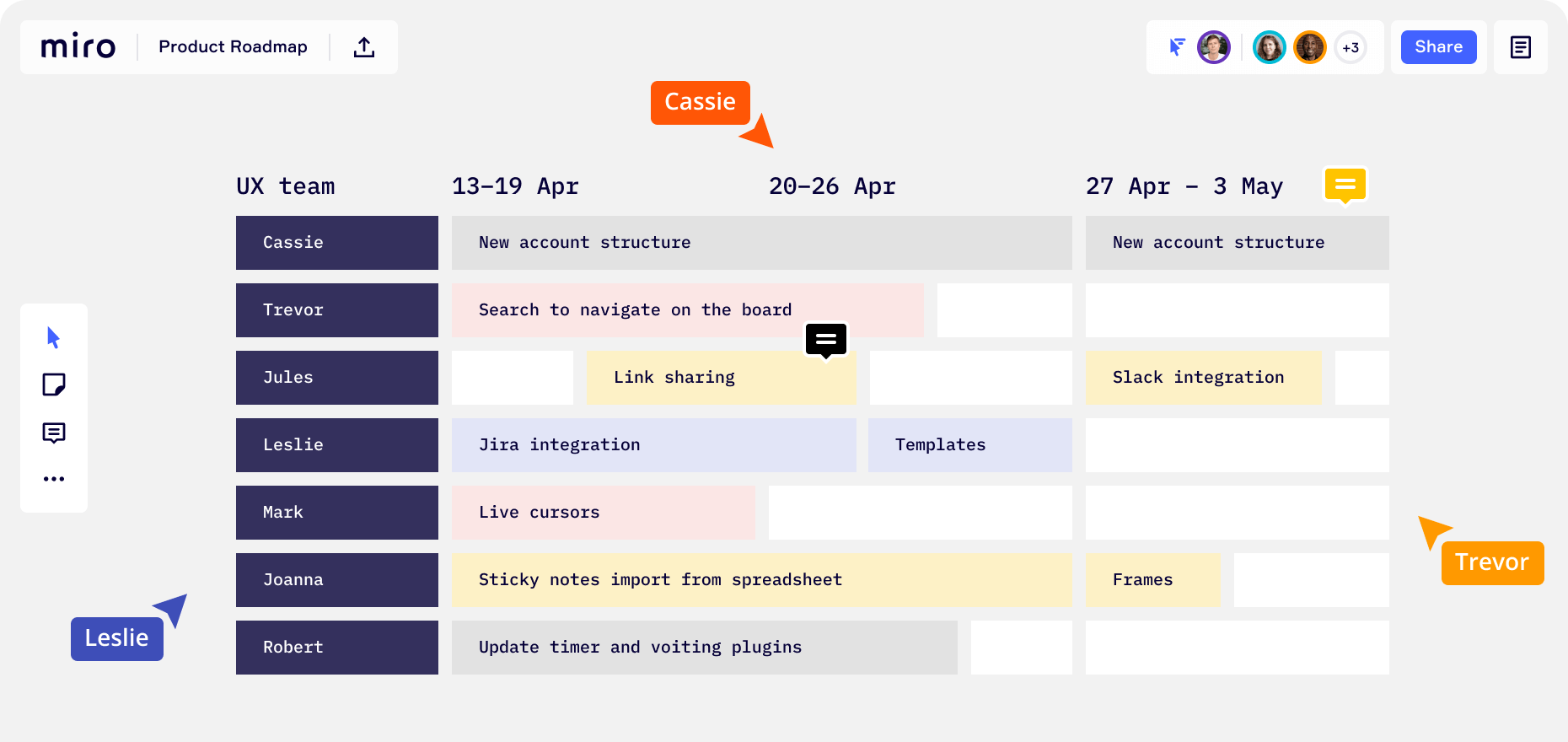 Miro is an online collaborative whiteboard platform that enables remote workers to work more effectively. From brainstorming with digital sticky notes to planning and managing agile workflows, you can use a host of collaboration tools to make teamwork effortless. Miro also allows you to use video chat, presentations, share screens and many other features.
Miro is an online collaborative whiteboard platform that enables remote workers to work more effectively. From brainstorming with digital sticky notes to planning and managing agile workflows, you can use a host of collaboration tools to make teamwork effortless. Miro also allows you to use video chat, presentations, share screens and many other features.
Stormboard
- Pricing: Free - $10 per user/month
- Visit Stormboard
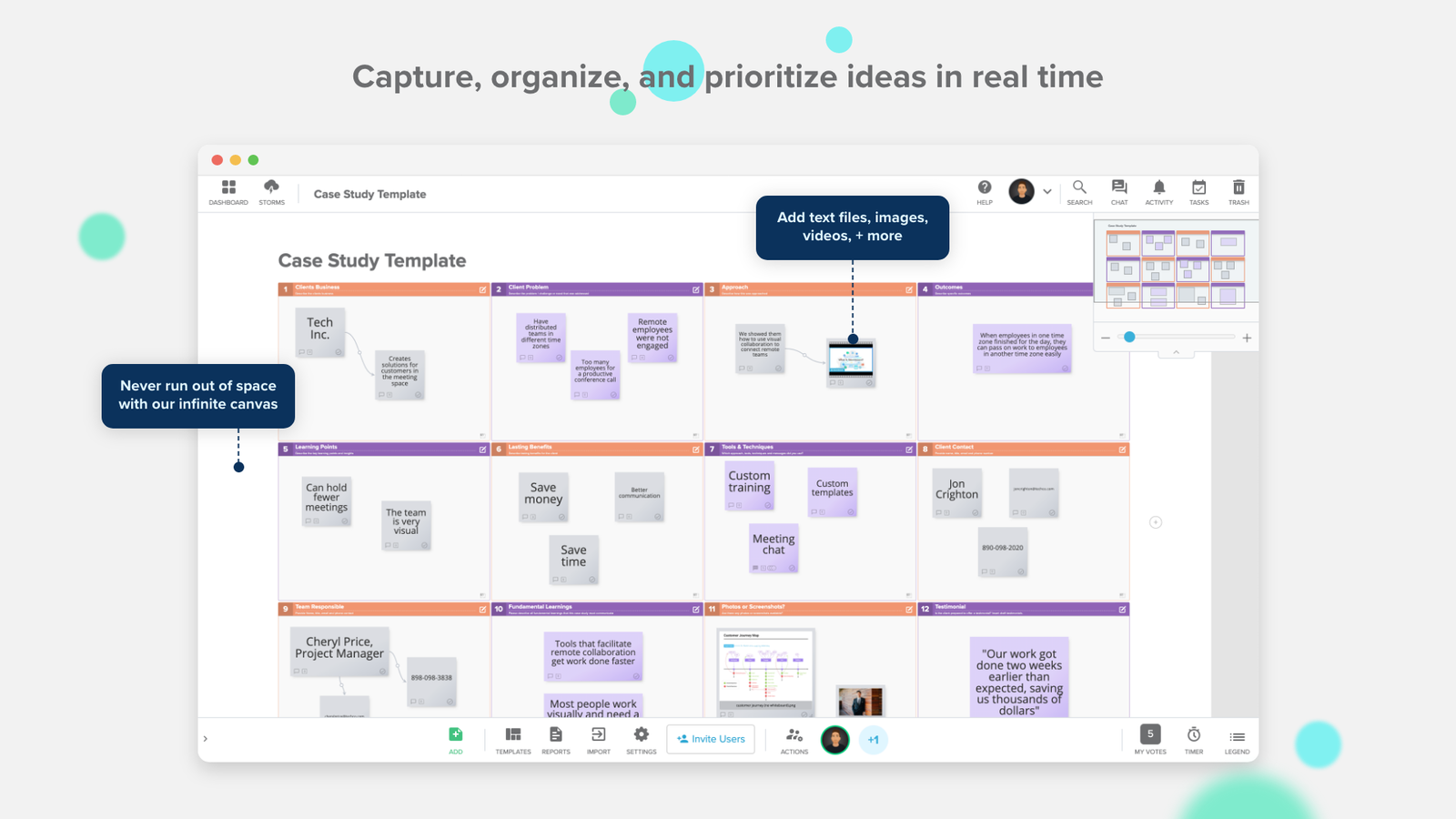
The last asynchronous tool we'll show you is Stormboard: a sticky-note-style whiteboard tool. Teams can drop notes or index cards with text, pictures, and even videos onto different sections of the board. Each digital sticky note can house its own whiteboard, opening up a world of opportunity for big-picture brainstorming and collaboration. As soon as you create a new Storm (brainstorming board), you can start adding your ideas which can be edited in real time.
Now that you have the tools you need for asynchronous communication, it’s time to get started implementing them at work!







